“Is it safe to eat thawed chicken in the fridge for 5 days?” is a question that frequents countless home cooks keen on maintaining food safety standards while avoiding unnecessary food wastage. Proper storage and handling methods greatly impact the freshness and flavor of frozen chicken and determine its safety for consumption. Whether you’re a novice in the kitchen or a seasoned chef, understanding the optimal time frame and temperature to store thawed chicken in the fridge can help mitigate potential health risks, such as foodborne illnesses caused by harmful bacteria.
In this article, we aim to dispel any confusion, provide clear guidelines on the safety of consuming thawed chicken refrigerated for five days, and offer practical tips to preserve the quality of your poultry.
Is It Safe to Eat Thawed Chicken In Fridge For 5 Days?
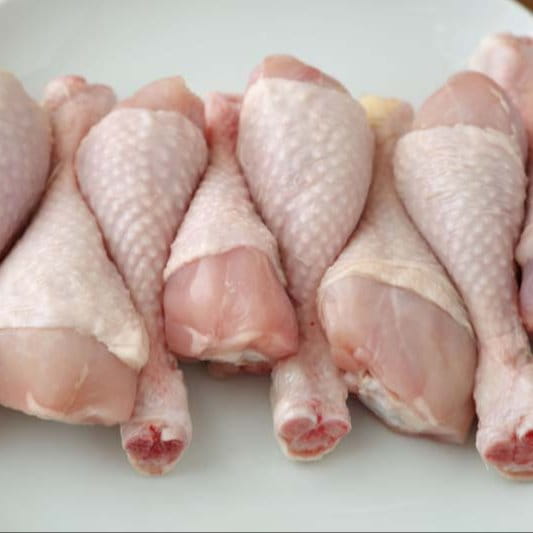
When it comes to thawed chicken in the fridge, it is generally not safe to eat it after five days. According to the USDA, thawed chicken can be stored in the fridge for up to two days after thawing. However, this timeline only applies if the chicken has been stored at less than 40 degrees Fahrenheit. If the chicken has been left out at room temperature for any period or there has been a power loss, it may become unsafe to eat even before the two-day timeline has passed.
It is important to check the chicken’s color, smell, and texture before consuming it. It is best to discard it if it has a gray, green, or blue tint, an unpleasant odor, or a slimy texture. Thawed chicken can also be stored in the freezer for several months, but its taste and texture may have been compromised during thawing. It is recommended to cook the chicken as soon as possible after thawing to maintain palatability.
Proper storage methods, such as tightly wrapping the chicken in plastic or placing it in an airtight container, can help prolong its shelf life in the fridge. Ultimately, following recommended guidelines and timelines for storing thawed chicken in the fridge for the safest consumption is best.
How Can You Determine If The Thawed Chicken In Your Fridge Is Still Safe To Eat After Five Days?
Determining the safety of thawed chicken in the fridge after five days requires carefully examining its color, odor, and texture. Whether frozen or thawed, raw chicken should never be stored in the fridge for more than two days. Cooked chicken can last up to four days, but it is still best to consume it as soon as possible to maintain its quality.
To check if the chicken has gone bad, one should look at the expiration date, smell it, and examine its color, texture, and appearance for any signs of spoilage. Spoiled chicken typically has a pungent odor, slimy texture, and a gray-green or blue tint. In case of any doubts, it is always better to err on the side of caution and discard the chicken instead of consuming it to avoid the risk of foodborne illnesses.
Read more:
- Sell-By Date On Chicken
- Raw Chicken in Fridge for 7 Days
- How Long Can Chicken Marinate In The Fridge
- Can You Marinate Frozen Chicken
- Can You Grill Frozen Chicken
What Is The Maximum Safe Storage Time For Thawed Chicken In The Fridge?
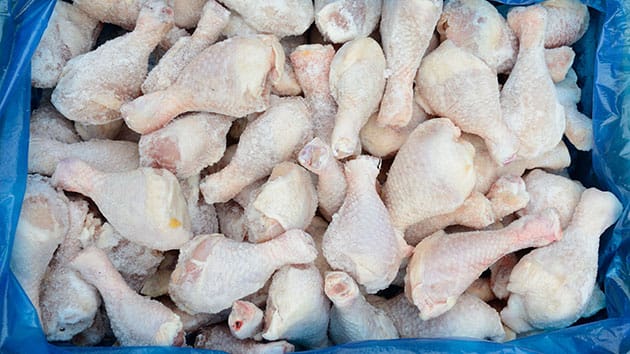
According to the USDA, the maximum safe storage time in the refrigerator is two days for thawed chicken. This applies to all types of chicken, including whole chicken and chicken pieces. Maintaining a temperature of less than 40 degrees Fahrenheit is essential when storing chicken in the refrigerator.
If the chicken has been left out or exposed to temperatures above 40 degrees Fahrenheit, it may spoil more quickly and become unsafe to eat. Keeping raw chicken in the fridge for over two days is not recommended, as the flavor and texture may be compromised. If the chicken has been cooked, it can last up to three to four days in the fridge, but consuming it as soon as possible is still recommended.
To store thawed chicken properly, wrap it tightly in plastic and seal it in an airtight container. It is also advisable to mark the storage date on the packaging to monitor its freshness. If you can’t cook thawed chicken within two days, it’s best to refreeze it, but be aware that the taste and texture may be affected during the thawing process. Following safe thawing methods, such as thawing in the refrigerator or microwave and never thawing at room temperature, is essential.
What Are The Key Risks Associated With Consuming Thawed Chicken That Has Been Stored In The Fridge For Too Long?
While it may be tempting to keep leftovers in the fridge for a few extra days, it’s essential to be aware of the risks associated with consuming thawed chicken stored in the fridge for too long.
One of the key risks is the potential for bacterial growth. When chicken is thawed, bacteria can begin to grow on the surface of the meat. If the chicken is stored in the fridge for too long, those bacteria can multiply and spread, increasing the risk of foodborne illness.
Another risk is the potential for the chicken to spoil. When meat is left in the fridge too long, it can develop an off smell and texture. This can be a sign that the chicken has started to spoil, and consuming it can lead to illness.
In addition to these risks, there are concerns about the chicken’s quality. When meat is left in the fridge for too long, it can lose its flavor and texture. This can make the chicken less enjoyable, even if it is safe to consume.
What Temperature Range Should Chicken Be Stored At To Prevent Bacterial Growth?
Food safety experts say storing chicken at the right temperature is crucial to prevent bacterial growth. The temperature danger zone in which bacteria thrive is between 40°F (4.4°C) and 140°F (60°C).
Raw chicken should be purchased before check-out and placed in a plastic bag to prevent leakage and cross-contamination with other foods. Once at home, it should be refrigerated immediately. Leftover cooked chicken should also be refrigerated within two hours of cooking and should not be left at room temperature for more than two hours.
Chicken should be cooked to an internal temperature of at least 170°F in the breast area and 175°F in the thigh area, checked in multiple locations using a meat thermometer. If stuffing a chicken, it should reach an internal temperature of 165°F. Cutting boards, utensils, and work areas must be thoroughly cleaned with hot soapy water after being exposed to raw chicken to prevent cross-contamination of bacteria.
What Is The Best Way To Thaw Frozen Chicken?
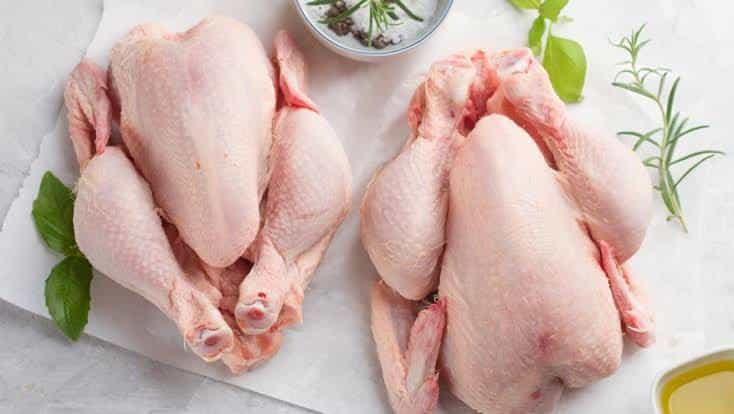
When thawing frozen chicken, the safest and most recommended method is to place it in the refrigerator. This process requires some planning as it can take up to 24 hours for the chicken to defrost fully.
Alternatively, a cold water bath can be used, submerging the chicken in cold water and changing it every 30 minutes until fully defrosted. Microwave defrosting is also an option, but cooking the chicken right away is essential as this method can create warm spots that are potential breeding grounds for bacteria.
Never defrosting chicken at room temperature is crucial as this creates a danger zone for bacterial growth. Thawing and correctly cooking poultry will help reduce the risk of foodborne illnesses significantly, and individuals should take food safety seriously by adhering to recommended defrosting methods.
How To Tell If Thawed Chicken Has Gone Bad?
It can be difficult for thawed chicken has gone bad to tell just by looking at it, but there are a few signs you can look out for that will help you determine whether or not your chicken is still safe to eat.
First and foremost, use your senses. Look at the chicken and check for any discoloration or odd spots. If it looks slimy or has an off-color, it’s a sign that the chicken has gone bad and should be thrown out. Additionally, if the chicken smells bad, that’s another clear signal that it’s unsafe to consume.
Next, touch the chicken. If it feels slimy or sticky to the touch, it’s a sign that bacteria has started to grow and it’s no longer safe to eat. On the other hand, if it feels dry or has a slightly tacky texture, it’s more likely to be safe.
Finally, you can also use a thermometer to check the temperature of the chicken. The USDA recommends that chicken be cooked to an internal temperature of 165°F (74°C). If the chicken is still cold in the center or below this temperature, it’s unsafe to eat.
It’s important to note that even if the chicken looks and smells fine, it could still be contaminated with harmful bacteria such as salmonella or E. coli. Always handle chicken carefully and cook it thoroughly to reduce the risk of foodborne illness.
How Long Can You Keep Cooked Chicken in the Fridge?
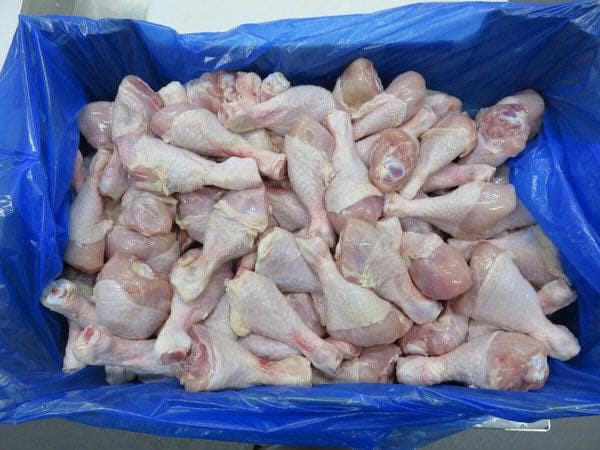
According to the U.S. Department of Agriculture’s (USDA) guidelines, the leftover cooked chicken should be refrigerated at 40°F or lower and used within three to four days. When storing cooked chicken in the fridge, ensure it is in an airtight container labeled with the date it was put in the fridge. It is essential to store cooked chicken within two hours of cooking to prevent bacterial growth.
Remember, rinsing or reheating cooked chicken that has gone bad will not kill bacteria or destroy toxins and may increase contamination of other foods and utensils, leading to an increased risk of food poisoning.
How to Store Thawed Chicken Properly?
Improper storage of thawed chicken can lead to foodborne illnesses, which can be unpleasant and dangerous. So, how do you store thawed chicken properly? Here are some tips that I’ve learned over the years:
- Use airtight containers: It’s important to store thawed chicken in an airtight container. This will help prevent bacteria from multiplying and causing illness. I prefer to use glass containers with locking lids, but plastic containers with tight-fitting lids work just as well.
- Label and date the container: It’s easy to forget when you thawed your chicken, especially if you have a busy schedule. That’s why I always label and date the container with the thawing date. This helps me track how long the chicken has been thawed, which is important for food safety.
- Store in the refrigerator: Once the chicken is thawed, it should be stored at a temperature of 40°F or below. This will help slow down the growth of bacteria and ensure that the chicken stays fresh for as long as possible. I always make sure to place the chicken on the bottom shelf of the refrigerator to avoid any cross-contamination with other foods.
- Use within 2-3 days: Thawed chicken should be used within 2-3 days of being thawed. After that, it starts to lose its freshness and can become unsafe to eat. If you don’t think you’ll be able to use the chicken within that time, consider freezing it again for later use.
- Don’t refreeze: It should not be refrozen once you thaw the chicken. This is because thawing and refreezing can cause the chicken to lose its flavor and texture, leading to the growth of harmful bacteria.
Do You Have to Thaw Frozen Chicken Before Cooking It?
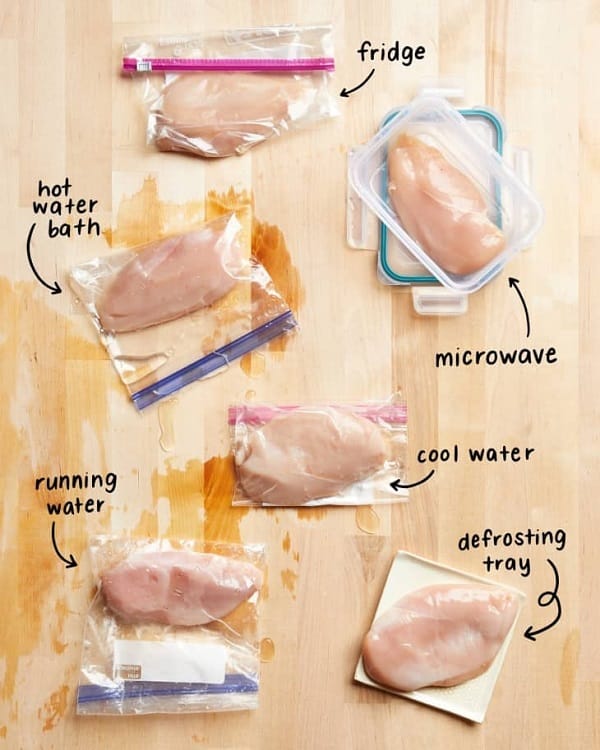
According to experts, It is unnecessary to thaw frozen chicken before cooking it. Cooking chicken directly from the frozen state in the oven or stovetop is safe. However, it should be noted that cooking frozen chicken takes approximately 50 percent longer than cooking thawed chicken. To ensure that the cooked chicken is safe to eat, it is important to use a food thermometer to check that the internal temperature has reached at least 165° F throughout.
Cooking frozen chicken in a slow cooker or microwave is not recommended, as this can lead to unsafe bacterial growth or uneven cooking. Defrosting chicken in the microwave is possible, but it should be cooked immediately to ensure it is not left in the “temperature danger zone” for too long.
Can You Refreeze Defrosted Chicken?
According to the USDA, it is safe to refreeze defrosted chicken as long as it has been thawed properly. This means the chicken should not have been left at room temperature as bacteria multiply rapidly between 40°F and 140°F.
The best ways to thaw chicken include refrigerators, cold water, or microwaves. Boneless chicken may thaw in 12 to 24 hours, while bone-in parts and whole chickens may take one to two days or longer to thaw completely.
Once thawed, the chicken should be used within one to two days, but if this is not possible, it can be refrozen as long as it is not left at room temperature for more than 24 hours. To avoid freezer burn, chicken stored for over two months should be wrapped in heavy-duty foil, plastic wrap, or freezer paper or placed inside a freezer bag.
Tips for Cooking Thawed Chicken
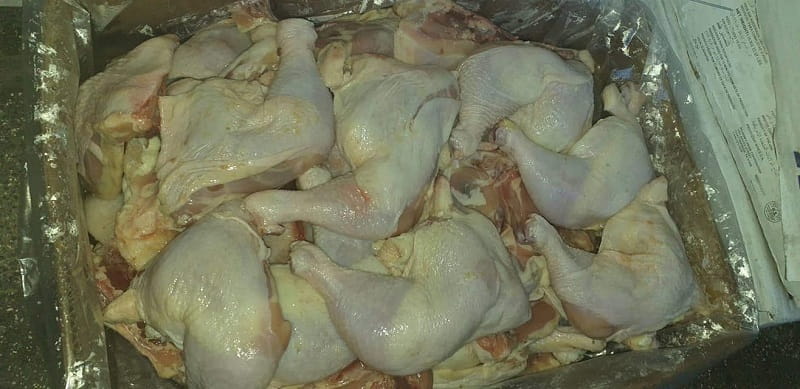
Here are some tips for cooking thawed chicken that I’ve learned over the years:
- Pat dry your chicken. Before you start cooking, pat your chicken dry with paper towels. Moisture outside your chicken can cause it to steam instead of sear, affecting the final dish’s taste and texture.
- Preheat your pan. Always preheat your pan before adding your chicken. This ensures your chicken cooks evenly and develops a nice golden brown crust. I recommend using a non-stick pan or a cast-iron skillet for best results.
- Season your chicken. Don’t be afraid to season your chicken with salt and pepper. Add other herbs and spices to flavor your chicken, such as garlic powder, paprika, or thyme. Be careful not to over-season, as this can overpower the meat’s natural flavor.
- Cook your chicken over medium heat. Cooking your chicken over medium heat will ensure that it cooks all the way through without burning on the outside. If your pan is too hot, the outside of your chicken may burn before the inside is fully cooked.
- Use a meat thermometer. The only way to know if your chicken is cooked through is to use a meat thermometer. The internal temperature should reach 165°F (74°C) before eating is safe. Ensure you check the temperature in the thickest part of the chicken, away from bone or fat.
- Rest your chicken before serving. Once your chicken is fully cooked, please remove it from the pan and let it rest for a few minutes before serving. This allows the juices to redistribute throughout the meat, making it more tender and juicy.
How Can You Prevent Cross-Contamination When Handling Thawed Chicken?
Cross-contamination can lead to food-borne illnesses and can even be life-threatening. Here are some simple steps to prevent cross-contamination when handling thawed chicken.
- Wash your hands: The most important step in preventing cross-contamination is to wash your hands thoroughly with soap and hot water before and after handling raw chicken. This will help to remove any bacteria on your hands that could be transferred to the chicken or other surfaces in your kitchen.
- Use separate cutting boards: Using separate cutting boards for raw chicken and other foods can also help prevent cross-contamination. Choose an easy-cut cut board to clean and disinfect, and designate one for raw chicken and another for other foods. This will help to prevent any bacteria from the chicken from spreading to other foods.
- Store chicken properly: Proper storage of thawed chicken is also essential in preventing cross-contamination. Store the chicken in a leak-proof container or plastic bag to prevent juices from leaking onto other foods in the fridge. Keeping the chicken on the fridge’s bottom shelf is also important to prevent drips from contaminating other foods.
- Clean and disinfect surfaces: After handling raw chicken, it’s important to clean and disinfect all surfaces that come into contact with the chicken, including countertops, cutting boards, and utensils. Use hot, soapy water and a disinfectant cleaner to ensure that all bacteria are killed.
- Cook chicken thoroughly: Finally, cooking chicken thoroughly is also important in preventing cross-contamination. Be sure to cook the chicken to an internal temperature of 165°F to ensure that all bacteria are killed. Use a meat thermometer to check the temperature and avoid guessing.
FAQs
What Are The FDA Guidelines For Handling And Storing Chicken?
The FDA provides guidelines for handling and storing chicken to ensure food safety. Raw chicken is often contaminated with harmful bacteria and can cause food poisoning if improperly handled. To prevent contamination, it is essential to keep raw chicken and its juices away from ready-to-eat foods, such as salads or cooked food.
Before handling chicken, always wash your hands with warm water and soap for at least 20 seconds. After preparing chicken, use a separate cutting board for raw chicken and wash utensils, dishes, and countertops with hot soapy water. Cook chicken to a safe internal temperature of 165°F and refrigerate or freeze leftover chicken within two hours. It is also recommended to place chicken in a disposable bag before putting it in the shopping cart or refrigerator to prevent raw juices from getting onto other foods.
What Are The Symptoms Of Food Poisoning From Eating Thawed Chicken?
Food poisoning from eating thawed chicken can cause a variety of symptoms. These symptoms may include nausea, vomiting, stomach cramps, diarrhea, and fever. Symptoms usually appear within a few hours of eating the contaminated chicken but may take up to a few days to develop. People with weakened immune systems, young children, and the elderly may experience more severe symptoms. In some cases, food poisoning from chicken can lead to complications such as dehydration, kidney failure, and even death.
It is important to seek medical attention if symptoms persist or are severe. The best way to prevent food poisoning from thawed chicken is to handle and cook it properly. Thaw chicken in the refrigerator and cook it to an internal temperature of 165°F. Keep raw chicken separate from other foods and wash hands and surfaces thoroughly after handling it.
Conclusion
In conclusion, is it safe to eat thawed chicken in the fridge for 5 days? Eating is generally unsafe, but it’s important to use your senses to determine whether it’s still safe. If in doubt, it’s always better to throw it out and avoid the risk of food poisoning. By following safe food handling practices, you can enjoy delicious and safe meals every time.
References:
- https://www.healthline.com/health/food-nutrition/how-to-defrost-chicken-the-safe-way
- https://www.cdc.gov/foodsafety/chicken.html
- https://www.fda.gov/food/people-risk-foodborne-illness/meat-poultry-seafood-food-safety-moms-be
- https://www.healthline.com/nutrition/temperature-danger-zone

Hey readers! Chip Holland here, and I’m a Manager of this website. My passion for writing about it only matches my passion for BBQ. Follow my blog for mouth-watering recipes, tips, and tricks for the perfect smoke, grill, and BBQ. I’m sure you won’t be disappointed!
